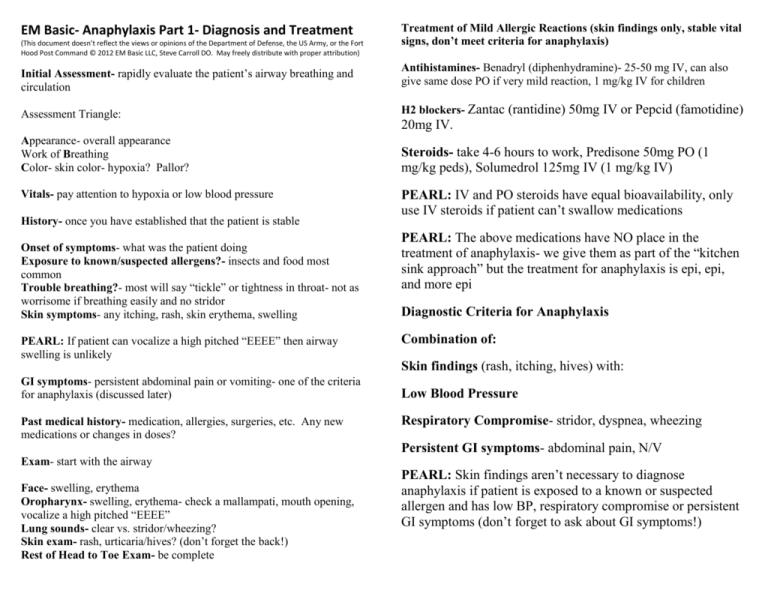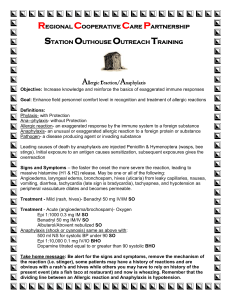Anaphylaxis Part 1- Diagnosis and Treatment Show Notes
advertisement

EM Basic- Anaphylaxis Part 1- Diagnosis and Treatment (This document doesn’t reflect the views or opinions of the Department of Defense, the US Army, or the Fort Hood Post Command © 2012 EM Basic LLC, Steve Carroll DO. May freely distribute with proper attribution) Treatment of Mild Allergic Reactions (skin findings only, stable vital signs, don’t meet criteria for anaphylaxis) Initial Assessment- rapidly evaluate the patient’s airway breathing and circulation Antihistamines- Benadryl (diphenhydramine)- 25-50 mg IV, can also give same dose PO if very mild reaction, 1 mg/kg IV for children Assessment Triangle: H2 blockers- Zantac (rantidine) 50mg IV or Pepcid (famotidine) Appearance- overall appearance Work of Breathing Color- skin color- hypoxia? Pallor? Steroids- take 4-6 hours to work, Predisone 50mg PO (1 mg/kg peds), Solumedrol 125mg IV (1 mg/kg IV) Vitals- pay attention to hypoxia or low blood pressure History- once you have established that the patient is stable Onset of symptoms- what was the patient doing Exposure to known/suspected allergens?- insects and food most common Trouble breathing?- most will say “tickle” or tightness in throat- not as worrisome if breathing easily and no stridor Skin symptoms- any itching, rash, skin erythema, swelling PEARL: If patient can vocalize a high pitched “EEEE” then airway swelling is unlikely 20mg IV. PEARL: IV and PO steroids have equal bioavailability, only use IV steroids if patient can’t swallow medications PEARL: The above medications have NO place in the treatment of anaphylaxis- we give them as part of the “kitchen sink approach” but the treatment for anaphylaxis is epi, epi, and more epi Diagnostic Criteria for Anaphylaxis Combination of: Skin findings (rash, itching, hives) with: GI symptoms- persistent abdominal pain or vomiting- one of the criteria for anaphylaxis (discussed later) Past medical history- medication, allergies, surgeries, etc. Any new medications or changes in doses? Low Blood Pressure Respiratory Compromise- stridor, dyspnea, wheezing Persistent GI symptoms- abdominal pain, N/V Exam- start with the airway Face- swelling, erythema Oropharynx- swelling, erythema- check a mallampati, mouth opening, vocalize a high pitched “EEEE” Lung sounds- clear vs. stridor/wheezing? Skin exam- rash, urticaria/hives? (don’t forget the back!) Rest of Head to Toe Exam- be complete PEARL: Skin findings aren’t necessary to diagnose anaphylaxis if patient is exposed to a known or suspected allergen and has low BP, respiratory compromise or persistent GI symptoms (don’t forget to ask about GI symptoms!) Epinephrine (Epi) Epi drip Sub-cutaneous injections (sub-q)- not done any more- shallow injection- sub-q layer not well perfused when pt is in shock Intramuscular (IM)- 0.3mg IM adult, 0.01 mg/kg peds x3 total doses Epi-Pen- some hospitals stock this in crash cart to avoid confusion about dosing- 0.3mg Epi-Pen IM for adults, 0.15mg Epi-Pen Junior IM for peds A word on concentrations of Epi 1:1,000: Concentrated Epi for IM injection 1:10,000: “Crash cart” Epi- only for patients without a pulse 1:100,000: Concentration of Epi in lidocaine with epi and epi drip, won’t cause tissue damage IV Epinephrine- for patients who don’t get better from IM Epi 1 amp crash cart Epi (1mg) Added to 1 liter of NS Run at 60 cc/hr, titrate up by multiples of 60 cc/hr (or just start at 600 cc/hr) Math 1 amp crash cart Epi = 1 mg Epi = 1,000 micrograms Epi 1,000 micrograms of Epi added to 1,000 cc of NS = 1 microgram Epi per cc Usual Epi drip run at 2-20 micrograms per minute 1 microgram per minute = 1 cc per minute = 60 cc/hr Even more dilute that 1:100,000 Epi so no concerns about tissue extravasation Two options- push-dose or drip Push dose Epi 10 cc of normal saline (NS), discard 1 cc = 9cc of NS Crash cart Epi- 1 cc Epi added to 9 cc of NS Push 1-2 cc every 2-3 minutes as needed until patient improves PEARL: ALWAYS be sure to label your syringes and IV bags if you mix up push-dose or a drip Special Situations Patient on Beta Blockers- they inhibit action of Epi, need to give glucagon to counteract (works by different pathway instead of Epi) Math: Crash cart Epi = 1 mg Epi in 10 cc or 1,000 micrograms in 10 cc = 100 micrograms per cc 100 micrograms per cc diluted 10 fold (9 cc NS) = 10 micrograms per CC Same concentration as 1:100,000 Epi (safe for local anesthesia and tissues) Glucagon- 1-5mg IV given slowly over 5 mintues, frequently causes vomiting, give with Zofran (ondansetron) Fluids- Give fluid boluses 1-2 liters of NS at a time, anaphylaxis causes vasodilation and capillary leak Vasopressors- If Epi doesn’t work, can try dopamine or norepinephrine Disposition Mild allergic reactions- skin findings only, no diagnostic criteria for anaphylaxis Discharge medications Benadryl 25-50mg PO TID PRN itching Prednisone 50mg PO daily for 5 days Zantac 150mg PO BID for 7-10 days Patient given Epinephrine- observe for at least 4-6 hours in the ED to make sure patient doesn’t have rebound (repeat) reaction, low threshold to admit Must discharge patient with Epi Pens- prescribe at least 2 Epi-Pensone for patient to carry with them at all times, one for home/school If possible- prescribe 3 Epi-Pens to have one on the patient at all times, one at home/school, and one in car (not great to have in hot cars in hot climates but better than nothing) PEARL: Be very clear with your discharge instructions about following up with primary care doctor and how to use Epi-Pen. Tell the patient not to wait for EMS to give Epi or it may be too late. Contact- steve@embasic.org Twitter- @embasic








